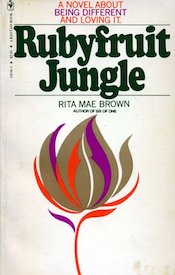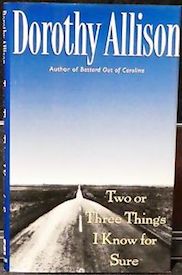My Queer Southern Lit
Tammy Lynne Stoner Recommends Rita Mae Brown, Fannie Flagg, and More
The South is where I was born, where I learned to talk, and where I threaten my ladyfriend with wanting to retire, despite the humidity and flying cockroaches and occasional hostility toward our type: the queers. This hostility may have much to do with the very southern trait of disliking change and the adherence to carefully highlighted portions of the bible, but it is odd considering how much of what we think about when we think about “The South” has to do with the queer characteristics: the fashionable swagger, the repressed bitterness, the screaming rebellion.
The struggling homosexual has been a force in southern lit, though often as a secondary character or as the unrecognized force that ruins lives. Often we only see the secret and true life of a queer character in the results of keeping that secret: the madness—or at least severe intoxication, the repression, the rampages. It’s like knowing a black hole exists even when we can’t see it because we can measure it’s pull on nearby objects. It’s the way the relationship between Idgie and Ruth in Fannie Flagg’s beloved novel Fried Green Tomatoes at the Whistlestop Café is never named and only hinted at.
Even knowing this, I didn’t realize how challenging it would be to create a round-up of Queer Southern Lit written by an LGBT writer with the main character/arc being about a queer character. So, after creating a good starter list, I stopped by Another Read Through bookstore and asked the owner, Elisa Saphier, for some help. Between the two of us—me a veteran of the queer publishing industry and her a bookstore owner, surely we could come up with a robust list of potentials! But as she and I culled through stack after stack, Elisa sighed. “Wow, this is tougher than I thought.”
In the end, though, a strong list took shape. Here, may I present, queer, southern writing through the decades that has both shaped and been shaped by The South, told by LGBTQ writers. These stories touch the soul—as any good story should—but also dare to touch on the love that too often, especially in The South, dare not speak its name.

Tennessee Williams, Cat on a Hot Tin Roof
No name more grandly evokes the desperation and passion of the dramatic south than Tennessee Williams, with characters like Amanda Wingfield in The Glass Menagerie, Alma Winemiller in Summer and Smoke, Blanche DuBois in A Streetcar Named Desire—“Stella!”—and Margaret “Maggie the Cat” Pollitt who plays opposite her repressed, drunk husband, Brick.
In Cat on a Hot Tin Roof (which won a Pulitzer Prize in 1955), Brick refuses to sleep with his hysterical wife to produce a much-needed heir. Brick has every advantage in this situation—the respect of his father-in-law who is dying and wants Brick to take over; the desperate passions of his wife; and his charming good looks, which have not faded despite his drinking. Yet still he tosses it all to the wind as he reels from the hold of his past, hidden love with a man named Skipper, who has since committed suicide.
The love between these two is the angry elephant in the room. It is not called out, but is still very much a presence. It is there—there and beastly, tearing everyone apart, especially Brick who at one point says: “One man has one great good true thing in his life. One great good thing which is true!—I had a friendship with Skipper.—You are naming it dirty!”
The “dirty bit” being the homosexual part. Sigh. But remember, this is the 1950s in the deep south and this is Tennessee Williams.
Williams himself lived the life of a tragic Southern character. He came down with diphtheria at five, nearly died, and was paralyzed for two years. At 26, his sister was institutionalized with schizophrenia. Their parents later volunteered her for an experimental lobotomy, which left her only semi-conscious for the remainder of her life, causing Williams to bitterly resent them.
Like Williams’ father (and many of his characters, including Brick), Williams struggled with alcohol, ultimately dying alone in a hotel room under odd circumstances that were originally listed as asphyxiation due to swallowing a bottle cap, though many question that. He did find love during his life, though, with Frank Merlo from 1948—until Frank died of cancer in 1963.
The southern themes in Williams’ life—hopelessness, madness, repressed homosexuality, alcoholism, resentment, impossible love—all play out gorgeously in his work.

Rita Mae Brown, Rubyfruit Jungle
Fannie Flagg and Rita Mae Brown lived together in the late 1970s, ultimately breaking up because they were “too different,” according to Flagg—something that can be seen also in their writing. Unlike the coy but loving partnership of Idgie and Ruth, Molly Bolt, the main character in Brown’s 1973 release, Rubyfruit Jungle, is nothing if not out.
Molly—God bless her—is an unrepentant lesbian in a time when there were hardly any unrepentant lesbians in literary works. I say this while Molly herself resists labels (putting her years ahead of her time). When asked if she’s queer, Molly says: “Why does everyone have to put you in a box and nail the lid on it?” Still, she is, and for that we thank you, Rita Mae Brown.

Fannie Flagg, Fried Green Tomatoes at the Whistle Stop Café
In 1987, Fannie Flagg’s Fried Green Tomatoes at the Whistle Stop Café comes out to rave reviews, followed by the movie—though with much less obvious girls-in-love content, which suited Flagg (who also wrote the script) just fine. “It’s a mainstream movie,” Flagg said in a 1992 interview with Entertainment Weekly. “People are taking children, they’re taking old people. It speaks to everybody. That’s what’s wonderful. They can make up their own minds.”
Sigh. Oh, Fannie.
Still, the book is gorgeously written, spanning many decades with a wide cast of characters that are described in several different points of view, including Dot Weems as The Weems Weekly—the local news sheet of Whistle Stop, Alabama. While the love between the women is not named, it is clear (in the book at least): “…[Ruth] knew she loved Idgie with all her heart… She had no idea why she wanted to be with Idgie more than anyone else on this earth, but she did.”

Dorothy Allison, Two or Three Things I Know for Sure
Three years before Dorothy Allison came out with Two or Three Things I Know for Sure in 1995, she released with Bastard Out of Carolina—which some folks might have chosen to put on this list instead of Two or Three Things. For me, though, Two or Three Things moved me more because it didn’t wreck me.
After reading Bastard Out of Carolina, I went to see the film. Anjelica Huston, the director, introduced it—her quiet voice in no way preparing us for the intense brutality of the film, which was originally supposed to air on TNT, but had to be shown on Showtime due to the graphic content. Trigger warning mayhem. I’m convinced I blocked half of it out.
It felt like Bastard Out of Carolina came into existence to purge Allison—who grew up being sexually abused by her step-father over twelve years, starting at age five, which lead to her contracting gonorrhea that left her unable to carry children. Allison no doubt needed to spend the decade she did writing Bastard before she could write Two or Three Things, her memoir.
Reading Two or Three Things felt like taking a walk into the heart and soul of Allison, a true southern character herself, with that cadence she does so well—like here:
They would come at me, those girls who were not really girls anymore. Grown up, wounded, hurt and terrible. Pained and desperate. Mean and angry. Hungry and unable to say just what they needed. Scared, aching, they came into my bed like I could fix it. And every time I would try. I would do anything a woman wanted as long as she didn’t want too much of me. As long as I could hide behind her need, I could make her believe anything. I would tell her stories. I would bury her in them. I have buried more women than I am willing to admit. I have told more lies than I can stand.
When I read this, all I can think and feel is: Yes, ma’am.

Silas House, Southernmost
Now, it’s 2018 and Silas House has come out with his sixth novel, Southernmost. In it, the life of the main character, Asher Sharp, is forever changed by his connection with two gay men who help his son.
Ah, change—that thing so much of The South often simply cannot abide. It’s this resistance to change that holds so many of Tennessee William’s characters hostage; it is what Molly Bolt and Dorothy Allison and, to a lesser degree, Idgie Threadgoode and Ruth Jamison, embrace in order to find themselves; and it is what drives Asher Sharp to rebel in Southernmost.
After getting to know the gay couple who helped his son, Asher can no longer stomach the Old World homophobia that afflicts his congregation and the local courthouse, who was refusing to give out marriage licenses to gay couples, and his own life, with his separation from his gay brother. In a gut wrenching rant in church that’s captured on video and goes viral after being released by his soon-to-be-ex-wife, Asher rails against the status quo and begs for change in his life and his community, not knowing how much would actually happen.
![]()

Tammy Lynne Stoner’s latest, Sugar Land, is available now.




















